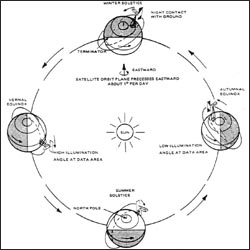Source: Landsat-6 Programming and Control Handbook

Like all of the Landsat satellites, Landsat-6 would have been in a sunscreen orbit had its launch been successful.
The L6 Handbook tells us, “Establishment of the sun-synchronous orbit provides for minimal variation of solar illuminations at the spacecraft and at the observed Earth scene. This occurs because of the near constancy of the geometry between the orbit plane and the sun vector. By achieving the correct combinations of altitude and orbit inclination, the orbit will precess about the geographic North Pole in the same direction (west to east) and at the same annual rate as the apparent Sun’s motion relative to the Earth. The geometry of the orbit-Earth-Sun relationship by season is shown in [this figure]. This figure also indicates how ground scene illumination is affected by changes in season. Such seasonal variations also have an impact on illumination at the spacecraft.”


